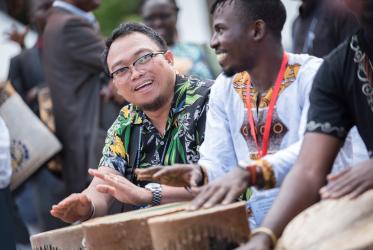The former director of biblical studies at the World Council of Churches (WCC), Rev. Dr Hans-Ruedi Weber, has died at the age of 97.
During his long career, Weber, who passed away on 18 October, made the Bible come alive for thousands of people through Bible studies that he coordinated with groups from many different cultures, contexts and situations.
In a tribute, WCC moderator Dr Agnes Abuom recalled first meeting Weber when she worked as an associate youth director at the WCC in 1978.
“He came with new liturgical and Bible study materials,” she said. “His face always glowed with joy as he either travelled to one of the islands or when he came back.”
Abuom thanked Weber for leaving behind a very rich liturgical and Bible study tradition. “You leave behind pillars of the word of God in our hearts and in our daily lives,” she said.
“Weber leaves behind a solid legacy to the one ecumenical movement, for which he showed great passion. He guided hundreds of Christians in developing their own gifts and skills for empowering groups, small and large, so that together they could have a deeper encounter with the biblical message,” said Rev. Prof. Dr Ioan Sauca, WCC interim general secretary.
One of Weber’s best known books was On a Friday Noon: Meditations under the Cross, which matched artworks related to the crucifixion with biblical reflections, and was translated into different languages. Another widely-circulated book, Experiments with Bible Study, introduced readers and church groups to ways of getting to know the scriptures through music, drama and images.
Born on 21 March 1923, in Ruchwil, Switzerland, Weber served at the WCC as director of the department on the laity (1955-61), associate director and professor at the Ecumenical Institute Bossey (1961-71), and director of biblical studies (1971-88).
Baldwin Sjollema, first director of the WCC’s Programme to Combat Racism, in trying to summarize what working with his friend and colleague Rev. Dr Hans-Ruedi Weber meant, wrote: “His strong convictions for the oikoumene were: a passion for the world, the oikoumene, which is God’s first love and where God is at work through judgement and salvation. The search for a fuller obedience to the biblical faith in order to receive direction for the churches‘ prophetic calling to work for reconciliation, and a fostering of an ‘ecumenical con-spiracy,’ a common spirit and vision, fighting against divided, self-sufficient church life and working for a more credible witness and service in the world. That task is hopefully still at the heart of the oikoumene, though today we may translate it in other words.”
Weber had previously served as a missionary in Central Celebes and East Java after being ordained a Swiss Reformed pastor in 1947. He obtained a doctorate in theology from the University of Geneva in 1966. After retirement from the WCC in 1988, Weber taught at the Pacific Theological College in Suva, Fiji.
In his work with the WCC, Weber travelled throughout the world to support the biblical work of churches in very diverse contexts and situations.
In 1961, Weber accompanied Lesslie Newbigin to the Malua Assembly as a young missiologist. In November 1984 Weber visited Samoa for ten days as moderator of the WCC Task Force in an attempt to heal the resentments between the Congregational Christian Church in American Samoa and Congregational Christian Church in Samoa after the separation of the two churches in 1980.
“Bible study cannot focus on the Bible only as a literary document, but also as an oral tradition in storytelling and singing, as drama in worship and in symbolic acts, as a visible word through art and as a source of meditation,” Weber once wrote.
Among Weber’s other publications are The Book That Reads Me: A Handbook for Bible Study Enablers (1995), A Laboratory for Ecumenical Life: The Story of Bossey (1996), The Militant Ministry (1963), and Power: Focus for a Biblical Theology (1989).
Read Dr Agnes Abuom's tribute to Rev. Dr Hans-Ruedi Weber
(See Weber's bibliography below)

Conference on the Training of the Laity for their Ministry in the World, Bossey, 1956. Group with Suzanne de Dietrich and Hans-Ruedi Weber.
Hans-Ruedi Weber: A Selected, Annotated Bibliography (1956 – 2002)
The Communication of the Gospel to Illiterates, London, SPCK, 1957.
Sponsored by the Ecumenical Institute Bossey, in Switzerland, this study on the communication of the Christian message to illiterates seeks to respond to two questions: “How can the biblical message be communicated to illiterates?” And: “What lessons can be learnt from this missionary encounter with illiterates which have a bearing on Christian communication in general?” The study was based on Weber’s year of missionary experiences in Luwuk-Banggai, Celebes island, Indonesia. Weber was a missionary of the Dutch Reformed Church in Indonesia for almost four years.
“Four Lectures on the Role of the Laity and Lay-Movements within the Life and Mission of the Church Universal,” 1958.
These lectures were given to the 1958 Conference of the Association of YMCA secretaries of Great Britain and Ireland. Their themes: I. The Laity in the Apostolic Church; II. The field is the world; III. Preparing for Holy Worldliness; IV. Today and Tomorrow.
Asia and the Ecumenical Movement 1895-1961. London, SCM, 1966.
The result of a sabbatical year as faculty of the Ecumenical Institute at Bossey. This study of ecumenical history has a double aim, writes the author. The first is “to throw a challenge to the one-sided western and Christendom-centred view of Church history”. Part 1: The pioneering work of the ecumenical youth movements in Asia; part 2 follows the development of Western missions to the Asian Church; part 3: Experiences and insights of Asian Christian and churches re witness, service and the unity of the church; part 4: The Asian contribution to the ecumenical movement.
The Militant Ministry: People and Pastors of the Early Church and Today. Philadelphia, Fortress Press, 1963.
This book is based on the Knubel-Miller lectures given in the United States in 1963. Weber uses five military notions from the New Testament and the early Church to explore the ministry of the lay people as the “militant Church”. 1.Baptized to join a struggle; 2.Sent on a mission of peace; 3.Equipped for gracious service; 4. An army of victorious victims; 5. Disarming Joy. “The first four centuries of church history are for us today more relevant than the Reformation history which happened within a still continuing corpus christianum.”
Salty Christians. Sidney, Australian Council of Churches, 1963.
This brochure, published originally by the Australian Council of Churches, is based on lay training courses ministered by Weber in Asia at the invitation of the East Asia Christian Conference. In the beginning of the preface, he announces its biblical presupposition: “all members of the Church have received particular gifts... therefore everybody has something to contribute. (5)
The Invitation: Matthew on Mission, New York, Board of Missions of the United Methodist Church, 1971.
“To help Christians to discover the specific Matthean way of witnessing to Christ”. Weber uses three ways of studying the Bible: the reproduction of a work of art (he uses Rembrandt’s “Evangelist St. Matthew with the Angel”); the intellectual work; awareness of our time and environment.
A Child? A Story for Adults, Nutfield (England), National Christian Education Council, 1979.
Weber creates the character of Gallus, a Roman legionary who belongs to the fellowship of the mysteries of Mithras, to guide the reader through a narrative Bible study of two passages of the Gospel of Mark. The Bible study takes place at Rufu’s home in Rome. Rufus was a son of Simon, who carried the cross for Jesus. Weber was inspired by his 7-year old daughter to embed exegesis in a story in 1979, the International Year of the Child.
Jesus and the Children: Biblical Resources for Study and Preaching, Geneva, WCC, 1979.
The insights gained in A Child? (see above) are developed into four comprehensive Bible studies on Jesus and the children in the synoptic gospels. Four appendices help the reader to be better equipped to use the Bible studies. Weber shows that “Jesus transcended prevailing traditions about the position and education of children”.
On a Friday Noon, Geneva, WCC, 1979. Weber quotes his fellow citizen Paul Klee: “Art does not reproduce the visible, but makes visible”. Inspired by 33 reproductions of art work “from different centuries and cultures”, he meditates on the meaning of the cross.
Experiments with Bible Study: Suggestions on Why and How to Do Them, Geneva, WCC, 1981.
There seems to be a missing link, writes Weber, “between what happens in biblical scholarship and what happens in the everyday life of Christians”. Having worked for some thirty years on Bible studies, Weber compares them “to experiments in a scientific laboratory”. These 25 experiments constitute a comprehensive handbook for what he calls “barefoot biblical teachers”.
Immanuel: The Coming of Jesus in Art and the Bible, Grand Rapids, W.B. Eerdmans, 1984.
Weber follows here the pattern of On a Friday Noon: reproductions of art work accompanied by meditation, this time on the Nativity. The book is dedicated to the sisters of the Communauté de Grandchamp, Switzerland who, by the way, have prepared the resources for the Week of Prayer for Christian Unity 2021.
Living in the Image of Christ, Geneva, WCC, 1986.
Weber returns to theme of the ministry of (“lay”) Christians in today’s world by approaching three human quests and offering Christ’s responses: The human search for wisdom and Christ the sage; the human search for justice and Christ the crucified; and the human need for identity and Christ the artist. In the last chapter, Weber revisits Ephesians chapter 4, which in the 1950s and 1960s “played an important role in the reflection on the ministry of the laity”.
The Way of the Lamb: Christ in the Apocalypse – Lenten Meditations. Geneva, WCC, 1988.
Risk books series, 36. A series of Holy Week meditations given in the Chapel of the Ecumenical Centre in Geneva, in April 1987 is the origin of this book on the Apocalypse, “meant to become a help for liturgical celebrations”. John’s Revelation “is visual theology”, Weber notes. “It must be seen in order to be understood”.
Power: Focus for a Biblical Theology, Geneva, WCC, 1989.
Between Biblical scholarship and Bible studies, Weber reviews different biblical traditions on God’s power and their convergence in Jesus Christ. He writes: “...those who want to think and act biblically in today’s world must be willing to draw out the lines from biblical power struggles to those they themselves face in their own daily life and work.”
The Book that Reads Me: A Handbook for Bible Study Enablers, 1995.
The Bible presented successively as oral tradition, literally document, drama, and visible word is the theme of this book based on a training course for Bible study enablers co-organised by the World Student Christian Federation and the World Council of Churches Ecumenical Institute at Bossey, Switzerland in 1995.
The Courage to Live: A Biography of Suzanne de Diétrich, Geneva, WCC, 1995.
A 1956 picture of Suzanne de Dietrich and Hans-Ruedi Weber sitting side by side reminds us of the ministerial succession in Bible study in the World Council of Churches. This biography was based on three years of research on her books, journals, unpublished letters, and on interviews. “To come to Suzanne de Diétrich is to take part in almost a century of world history.”
A Laboratory of Ecumenical Life: The Story of Bossey, 1946-1996, Geneva, WCC, 1996.
There are several article and monographic studies dedicated to Bossey as an experiment on ecumenical formation. But there is just one story of Bossey: Weber’s A Laboratory of Ecumenical Life, written for the 50th anniversary of the Ecumenical Institute in 1996. The book was dedicated to “the children from many nations who grew up at Bossey”, and in particular to Marc, “a boy not yet two years old when he lost his life in the pond on one of his voyages of discovery around the château”. A new edition was published in 2016, on Bossey’s 70th anniversary, with an extra chapter by Robert Welsh.
Walking on the Way: Biblical Signposts, Geneva, WCC, 2002.
Weber’s last publication on the study of the Bible as personal formation, rather than just personal information, was a series of biblical meditations on the great Christian feasts: advent and Christmas, Holy Friday and Easter, Pentecost. Once again, Weber appeals to art, because “it makes visible”. In the autumn of life, he writes, “I was asked to write about the key biblical texts that have shaped me”.










